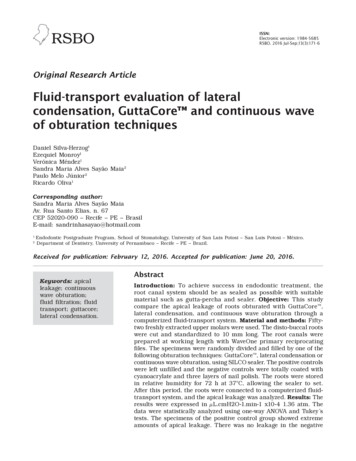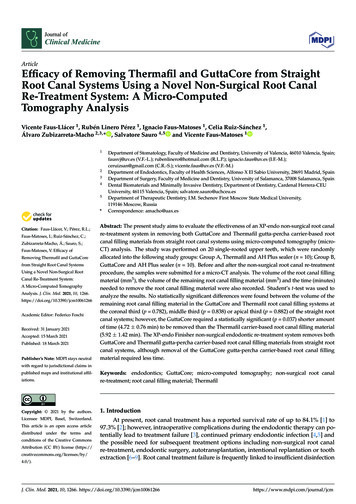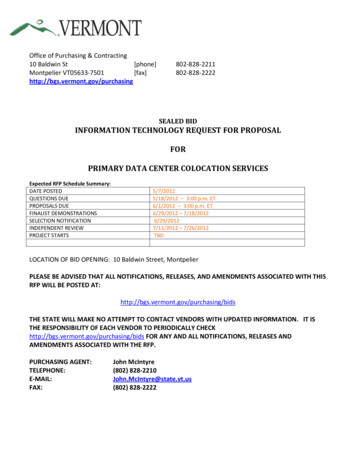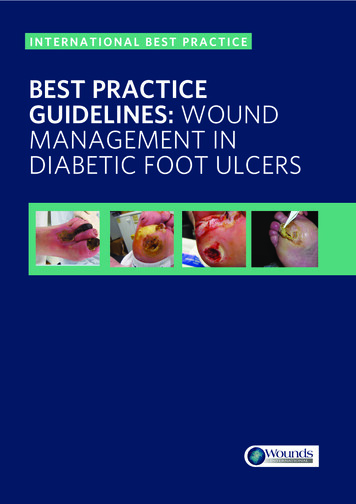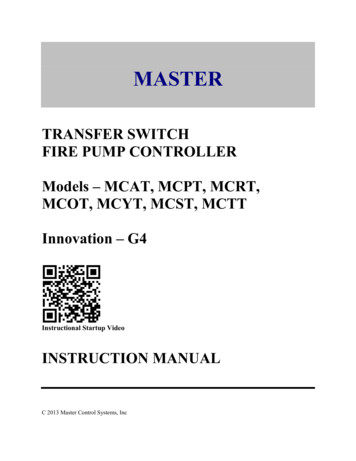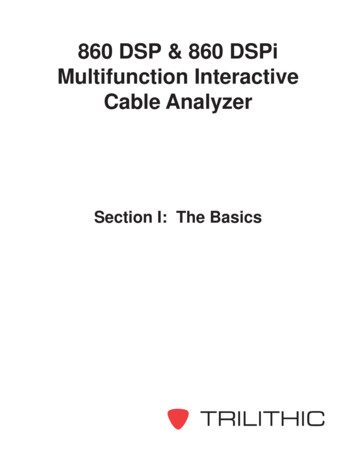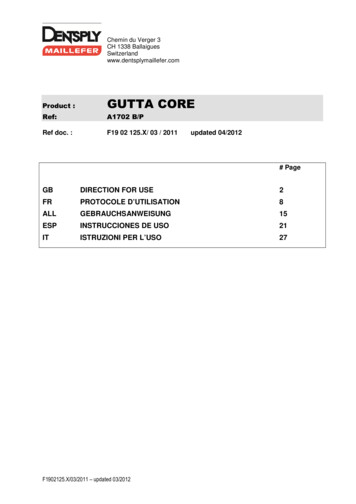
Transcription
Chemin du Verger 3CH 1338 uct :GUTTA CORERef:A1702 B/PRef doc. :F19 02 125.X/ 03 / 2011updated 04/2012# PageGBDIRECTION FOR USE2FRPROTOCOLE IONES DE USO21ITISTRUZIONI PER L’USO27F1902125.X/03/2011 – updated 03/2012
For dental use onlyDirections for UseRef A1702B/PDESCRIPTIONGuttaCore Obturators are used for filling root canal systems.I.INDICATIONS FOR USEThese products have to be used only in a clinical or dental environment, by qualified dentalusers.Application field: GuttaCore Obturators are used to fill the cleaned, shaped and irrigated rootcanal space.II.CONTRAINDICATIONSNone Known.III.WARNINGSThis product contains dry natural rubber.IV.PRECAUTIONS V.Select the GuttaCore Obturator according to the GuttaCore size verifier that fits theshaped canal passively.GuttaCore Obturator cores should not be used as size verifiers.Do not remove gutta-percha from the apical section of GuttaCore Obturator prior to fillingthe root canal space. Removing the gutta-percha may damage the obturator.ADVERSE REACTIONSPatients with latex sensitivity may experience allergic reactions to gutta-percha, which containsdry natural rubber.VI.STEP-BY-STEP INSTRUCTIONSDIRECTIVESPrior to using any new product, read all of the manufacturer’s instructions. Make sure that youare competent when using the product and technique prior to clinical use.Consider the following directives to ensure successful applications and outcomes.1. Create straight-line access to all root canal systems for application of both rotary and handfiles. Remember, the use of a rubber dam is the standard of care for endodonticprocedures.2. Use only clean files when entering the canal.3. Establish a coronal reference point.4. Determine the ideal working length position with an apex locator, radiograph or both.F1902125.X/03/2011 – updated 03/20122 / 33
5. Do not force any root canal instruments when negotiating or shaping the canal.With rotary instruments a crown-down technique is recommended.6. Shape and clean canals to sizes compatible with the root shape, size and curvature.Over enlargement of root canal systems should be avoided to preserve sound dentin and toprevent possible instrument damage in the canal space, e.g., ledging, creation of falsecanals, separation of instruments.7. Flare the canal coronally and ensure the GuttaCore Obturator has sufficient space toenter the root canal along the straight line access by using an orifice shaping instrument asnecessary such as X-Gates, GT Series X Accessory Files, ProFile O.S. or a ProTaper SX or S1 file.8. Proceed slowly with all instruments in areas of canal irregularity and curvature.9. Consider all root canal instruments for “single use/single case” applications, as wear andfatigue may impact the integrity of the instrument and result in separation with excessiveuse.10. Verify the canal size prior to obturating.11. Irrigate frequently throughout the cleaning and shaping procedure.STEP-BY-STEP INSTRUCTIONSThese instructions are designed to help gain an understanding of the technique and safeapplication of the product. Practice on plastic blocks and extracted teeth are stronglyrecommended prior to clinical applications.1. CrosslinkingCrosslinking is a well-known chemical process of linking polymer chains together.Crosslinking creates the subtle strength needed in a centrally compacting obturator.GuttaCore Obturators create the hydraulics you expect from DENTSPLY Maillefer obturatorswith the added benefit of having a gutta-percha core. It is important to note that Crosslinkedgutta-percha is not sticky, does not melt and will not dissolve with dental solvents.2. HydraulicsGuttaCore Obturators move warm gutta-percha 3-dimensionally into the root canal system.Many obturation techniques use lateral or vertical compaction, however the hydraulic force fromthese techniques generally moves gutta-percha in one or two unequal directions (laterally orapically). GuttaCore uses a crosslinked gutta-percha core for centrally compacting the flowinggutta-percha in the canal. The hydraulic force compacts warm gutta-percha flowing equally in 3dimensions. Proper cleaning, shaping and irrigation, along with the central compacting hydraulicforce facilitates the flow of gutta-percha in the root canal system.3. ShapingProper shaping removes pulpal tissue and dental debris permitting the GuttaCore Obturatorto move passively through the canal. Shaping begins by creating straight-line access andshaping the canal – crown down. Create Straight-Line AccessEstablish working length and create a glide path for the rotary files to follow.Negotiate all root canals to their terminus with stainless steel K-Files, in the presence ofGlyde File Prep root canal conditioner. Establish patency by taking a #10 K-File past thecanal terminus, and at least a #15 K-File to the terminus.F1902125.X/03/2011 – updated 03/20123 / 33
Shape Canal – Crown DownInitiate crown down shaping technique. Consult the file system’s directions for use todetermine the starting file in small canals (mesial and buccal canals of molars, smallpremolars and mandibular anteriors). Take the file to resistance or working length(whichever occurs first). If resistance is encountered before working length is obtained, goto next smaller instrument following the same protocol until working length is achieved.Between each rotary file recapitulate with a #10 or #15 tip hand file to maintain the glidepath to the canal terminus. Frequent irrigation with sodium hypochlorite (NaOCl) is usedthroughout the shaping procedure. Flare the CanalFlare the canal coronally and ensure the GuttaCore Obturator has sufficient space toenter the root canal along the straight line access by using an orifice shaping instrument asnecessary such as X-Gates, GT Series X Accessory Files, ProFile O.S. or a ProTaper SX or S1 file. Consult the File System Directions For UseConsult the file system’s directions for use to determine the file size for larger canals(palatal and distal canals of molars, larger premolars, maxillary anteriors).Use the crown down technique to resistance or working length. If resistance is encounteredbefore working length is achieved, move on to smaller sized instruments until workinglength is achieved. Between instruments, recapitulate with small hand instrument tomaintain a glide path to working length.Follow the file system’s directions for use when creating access, shaping the canal andflaring the coronal portion of the canal.A properly shaped canal preserves the natural shape of the anatomy and allows for a moreeffective volume of disinfecting irrigants to penetrate, circulate and clean all areas of theroot canal system.4. Verify the Shape at Working Length and Passive FitFollowing proper cleaning and shaping, confirm the final working length measurement using asize verifier that reaches the apical constriction passively, with no significant resistance ortwisting. It is necessary to use the GuttaCore size verifier from the obturator package toconfirm the shape at working length and passive fit.Verifying the shape at working length and passive fit ensures that the GuttaCore Obturatorbeing used matches the correct apical canal diameter.The size verifiers included in the GuttaCore package are made of nickel titanium and arefluted, making them excellent for minor apical shaping, if necessary. If the size verifier is slightlyshort of your working length, you can use it to enlarge to your working length by rotating it in aclockwise direction while exerting slight apical pressure.i.Remove the GuttaCore size verifier from the obturator package to confirm a passive fitat working length; set the silicone stopper at your working length using the size verifier’scalibration mark. Check passivity by taking the size verifier to working length and confirmby rotating in the canal 180 .ii.If the fit is passive, remove a GuttaCore Obturator from the package and proceed tostep 5.iii.If the fit is not passive, use the size verifier as a finishing file to gently enlarge the canalterminus or select a smaller size verifier. If the smaller size verifier fits passively, removea GuttaCore Obturator of the same size as the verifier and proceed to step 5.5. Irrigate the CanalF1902125.X/03/2011 – updated 03/20124 / 33
The cleaning of the shaped root canal system is accomplished primarily through the use ofcopious irrigation with NaOCl. Irrigants can be activated using a cavitation and acousticstreaming device or ultrasonic irrigation needle. The activated irrigants improve debridementand disrupts the smear layer and biofilm inside the canal, promoting deep cleaning anddisinfection of lateral canals, fins, webs, isthmuses, anastomoses, and dentinal tubules. Dry thecanal thoroughly using absorbent points.6. Selecting the Obturator and Setting Working LengthSelect a GuttaCore Obturator from the same package as the size verifier used to verify theshape of the working length and passive fit. Available GuttaCore Obturator sizes include:Final Shape.04 TaperGuttaCore ObturatorsFinal Shape.06 TaperGuttaCore 0455/.0460/.0470 /.0480 /.0490 40/.0645/.0650/.0655/.0660/.0670 /.0680 /.0690 /.06202530354045505560708090When the final shape is a .04 taper, select a GuttaCore Obturator package one size smallerthan the last file taken to working length. When the final shape is a .06 taper or larger, select aGuttaCore package of the same size as the last file taken to working length.Set the top of the silicone stopper on the GuttaCore Obturator to coincide with the workinglength established.Calibration rings are set at the following working lengths (in millimeters): 18, 19, 20, 22, 24, plus27 and 29 on the obturator handles.7. AsepsisDisinfect the obturator in a 5.25 sodium hypochlorite solution (bleach) for one minute.Gently wipe the gutta-percha on the GuttaCore Obturator with gauze moistened with 70%alcohol.F1902125.X/03/2011 – updated 03/20125 / 33
8. Drying the Canal and Applying SealerUse a sterile paper point of the same tip and taper as the last file taken to working length. Brusha very light coating of sealer (TOPSEAL ) with the paper point. To help ensure the obturatorreaches working length, use an additional absorbent point to remove any excess sealer thatmay have accumulated on the canal walls or pooled in the apex.If obturating more than one canal in a single tooth, place sealer in all the canals at the sametime. This facilitates removal of excess gutta-percha by preventing the gutta-percha fromsticking to other orifices or dentin.9. Heating GuttaCore Obturators in the Obturator OvenFor details on the use of the obturator oven, please refer to the GuttaCore Obturator OvenInstruction Manual.10. Placing Obturator in the CanalAfter the first signal “beep” of the GuttaCore Oven, the obturator is ready for use. Push theobturator holder and guide the holder with your finger. Take the obturator carefully out of theholder by first lifting it up a little and then pulling it toward you. The oven will “beep” every 15seconds to remind you that the obturator is still in the oven. After 90 seconds, the oven willswitch off automatically. Insert GuttaCore Obturator directly into orifice of canal. Avoidtouching the walls of the occlusal opening.Note: If the canal has been properly shaped and the gutta-percha properly heated, the obturatorshould seat to place without twisting or forcing. To avoid overextension, don’t force theGuttaCore Obturator beyond the working length. You will note a backflow of sealer and guttapercha resulting in an accumulation at the orifice. This is to be expected, especially in multir
Application field: GuttaCore Obturators are used t o fill the cleaned, shaped and irrigated root canal space. II. CONTRAINDICATIONS None Known. III. WARNINGS This product contains dry natural rubber. IV. PRECAUTIONS Select the GuttaCore Obturator according to the Gu ttaCore size verifier that fits the shaped canal passively.

